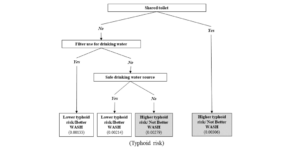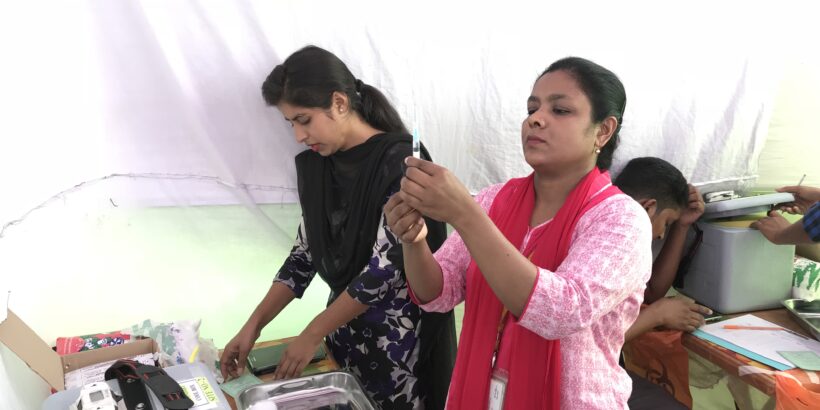More than half of the world’s population lives in urban areas and the numbers are increasing. Slums in low-income countries often develop quickly, unplanned, and with limited resources for infrastructure. Water, sanitation, and hygiene (WASH) facilities in slum settings are frequently inadequate, which can increase the risk of typhoid. Estimates suggest that typhoid causes more than 110,000 deaths and affects more than 9 million people worldwide every year. Blood culture surveillance estimated a high incidence of typhoid among urban slum residents in Dhaka, Bangladesh, with 200 episodes per hundred thousand people per year – one of the highest burdens in the world.
A recent study conducted in a densely populated urban slum in Dhaka found an association between existing improvements in WASH facilities and a reduced risk of typhoid, reminding us that an integrated approach is the best way to take on typhoid. We spoke with the researchers to learn more.
What did your study find about the effect WASH can have on typhoid control?
Our findings suggest that improvements in WASH facilities can contribute to enhanced typhoid control. Living in a household with “better” WASH facilities was associated with a reduction in typhoid risk. Improved WASH facilities help to reduce transmission of typhoid bacteria. However, major infrastructural improvements in urban slum settings can be difficult without significant financial capital and political commitment. We must remember that even small-scale WASH improvements can help control disease.
What does it mean to have “better WASH” in a household?
We formulated a “better” WASH composite variable based on households having a private toilet facility, a safe drinking water source, and the presence of a water filter. These three essential technologies can have a huge impact on the health of members living in the household. We predicted the risk of typhoid based on the combination of these WASH variables, comparing “better” versus “not better” household WASH status.

How did you determine “better WASH” reduced the risk of typhoid?
We conducted surveillance in eight clinical facilities in the study population and performed home visits of the study population. At the end of the study period, the incidence of typhoid in “better” WASH households was 139/100,000, compared to 252/100,000 in “not better” WASH households. This implies that households with “better” WASH have a 38% lower risk of typhoid. We observed the most reduction in typhoid risk among children younger than ten years of age who lived in “better” WASH households.
These findings also support integrating WASH improvements with typhoid conjugate vaccines (TCV), which can reduce the risk of typhoid. This implies that, in densely populated urban areas, multidimensional interventions such as improving WASH facilities combined with TCV programs could prevent exposure to and transmission of typhoid.
We know WASH interventions can be difficult for low-income families living in slum communities. What other tools help prevent typhoid?
We have known for a long time that an integrated approach of WASH plus vaccines drastically reduces the burden of diarrheal and enteric diseases. A study conducted in Kolkata, India, found a similar association between improvements in WASH and a reduction in typhoid risk in endemic slum areas. As we noted, WASH improvements can take time, resources, and require investments in the long term. TCV are a near term solution with 79-85% efficacy that can drastically reduce typhoid transmission and illness. More than 56 million children have already been vaccinated, which is great progress in places where WASH infrastructure remains inadequate.
Anything else you’d like to share?
Any public health intervention takes time and resources. But we know that WASH and vaccines are two of the most impactful solutions when it comes to enteric diseases such as typhoid. We need policymakers to prioritize WASH infrastructure improvements for their constituents while also prioritizing available vaccines that can save lives.
Cover photo: Health worker prepares a typhoid vaccine in Bangladesh. Credit: icddr,b.



